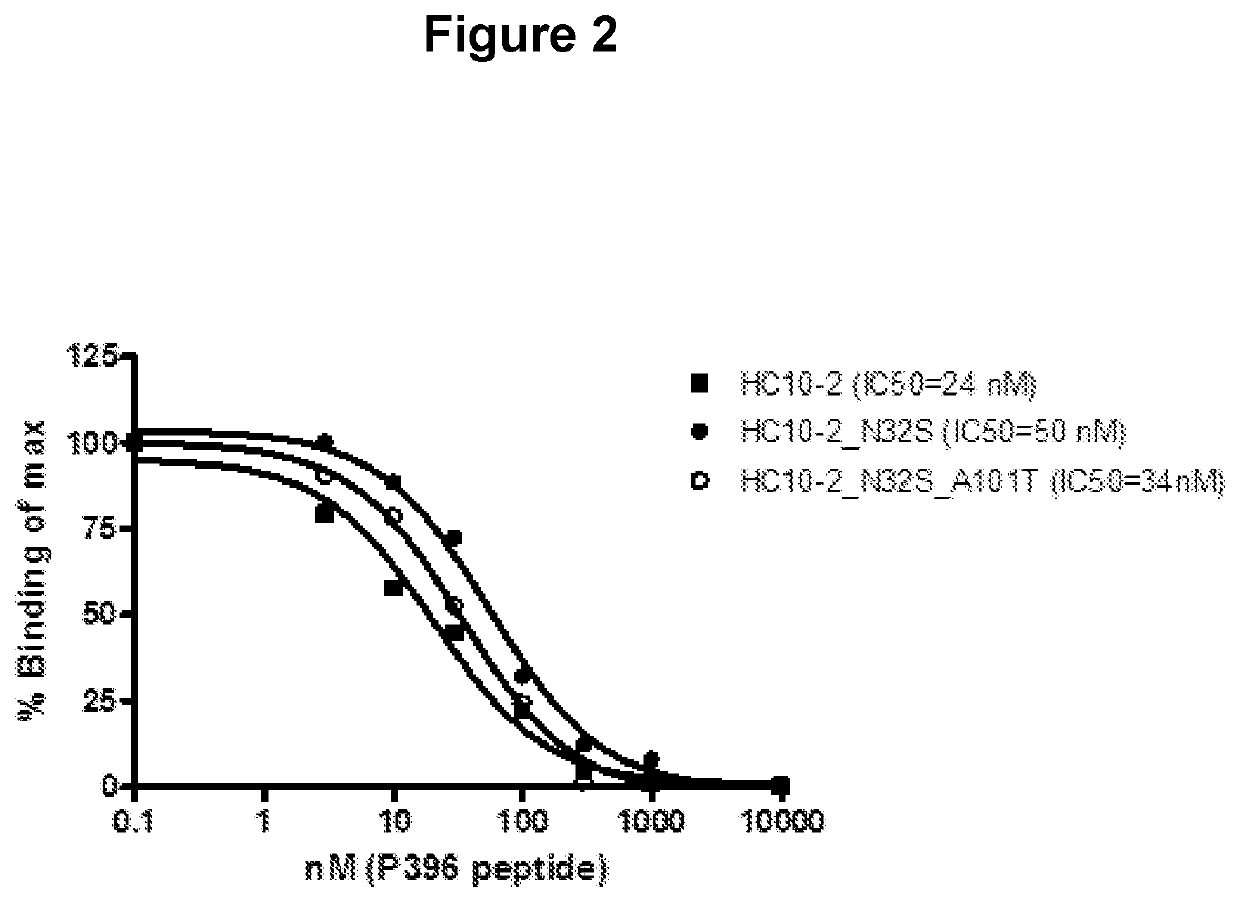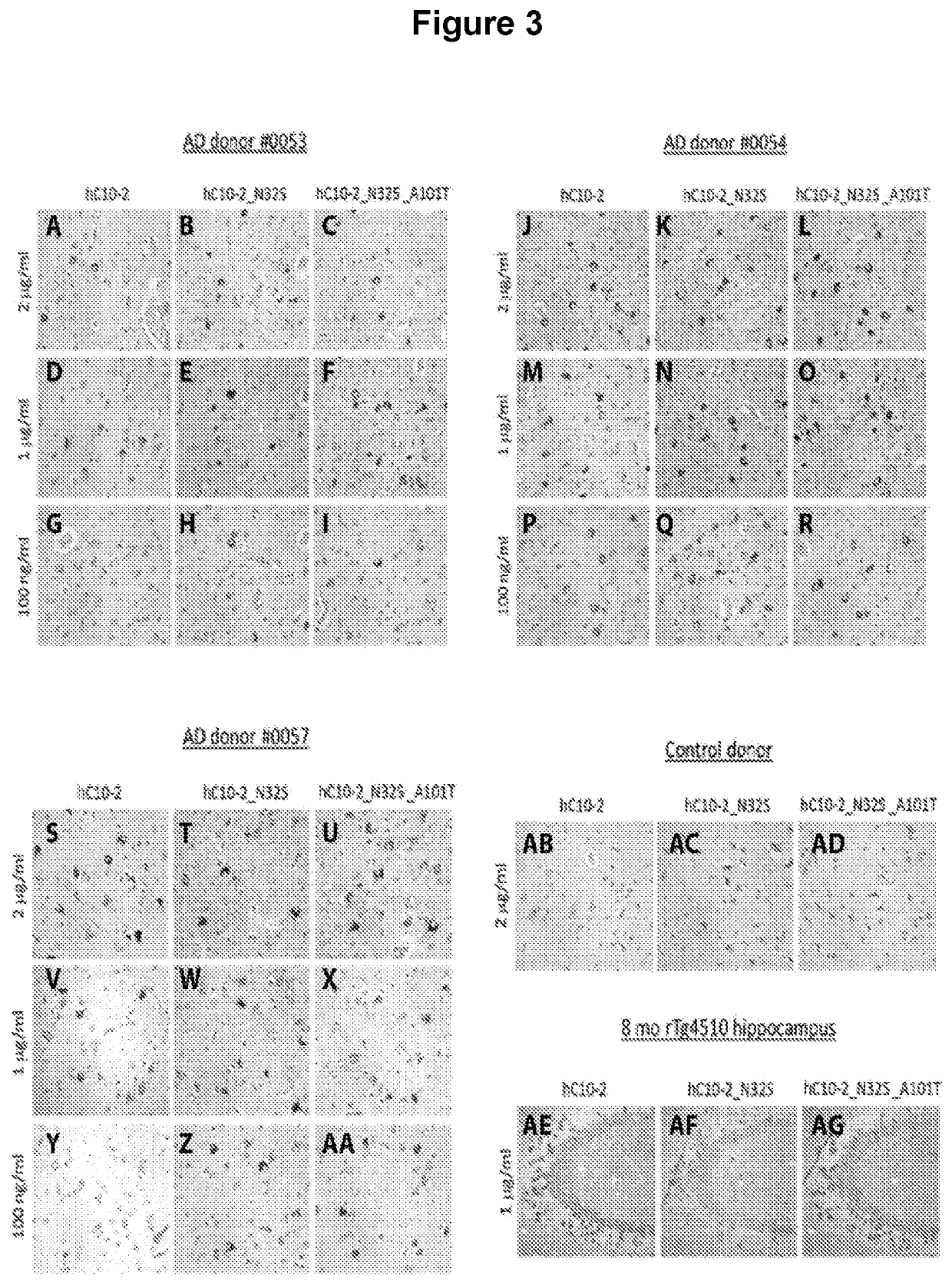Antibodies specific for hyperphosphorylated tau and methods of use thereof
a technology of anti-hyperphosphorylated tau and antibodies, applied in the field of monoclonal antibodies, can solve the problems of microtubule degeneration and spinal collapse, cell death, and malfunction of communication between neurons, and achieve the effect of easy detection and use, and easy detection and us
- Summary
- Abstract
- Description
- Claims
- Application Information
AI Technical Summary
Benefits of technology
Problems solved by technology
Method used
Image
Examples
example 1
ion of Mice with Tau Phospho-Peptides 396 / 404
[1348]C56 / BL6 and FVB mice were immunised with 10 μg P30 conjugated phosphorylated tau peptide 386-408 (pS396 / pS404) (SEQ ID NO:2) formulated in TiterMax adjuvant.
[1349]Mice (C56 / BL6 and FVB strains, female and male. 2-to 3-month-old mice were immunized with peptide epitope P30 conjugated phosphorylated tau 386-408.
[1350]Immunogenic P30 conjugated phosphorylated tau 386-408 (pS396 / pS404) peptide was formulated in TiterMax (400μg / ml peptide mixed 1:1 vol:vol) following the TiterMax / vendor protocol and mice were injected subcutaneously with 20 μg peptide (100 μl) of antigen. Control mice were injected with adjuvant only. All peptide-immunised mice were boosted with 0.5 μg peptide / Titermax (10 μg / ml peptide formulated as described above and injected) at monthly intervals. The mice were finally boosted with P30 conjugated phosphorylated tau 386-408 (pS396 / pS404) without Titermax 3 days prior to harvest of splenocyte followed by fusion of sple...
example 2a
Generation
[1351]The mice were boosted with P30 conjugated phosphorylated tau 386-408 (pS396 / pS404) without Titermax 3 days prior to harvest from spleens from responding mice followed by fusion of splenocytes with SP-2 cells. Hybridomas were selected for re-cloning cycles after positive binding to phosphorylated tau 386-408 (pS396 / pS404) detected by ELISA, and preferential binding activity to S1 and P3 antigens from AD and TG4510 brain lysate in comparison to brain lysate from controls using dot blots and brain lysate coated ELISA or MSD plates.
example 2b
ot and Dot-Blot Analysis of Specific Antibodies
Tau Biochemical Fractionation
[1352]Brain tissues from humans or rTg4510 mice overexpressing the human tau mutation P301L were homogenized in 10 volumes of Tris-buffered saline containing protease and phosphatase inhibitors as follows: 50 mM Tris / HCl (pH 7.4); 274 mM NaCl; 5 mM KCl; 1% protease inhibitor mixture (Roche); 1% phosphatase inhibitor cocktail I & II (Sigma); and 1 mM phenylmethylsulfonyl fluoride (PMSF; Sigma). The homogenates were centrifuged at 27,000×g for 20 min at 4° C. to obtain supernatant (S1) and pellet fractions. Pellets were re-homogenized in 5 volumes of high salt / sucrose buffer (0.8 M NaCl, 10% sucrose, 10 mM Tris / HCl, [pH 7.4], 1 mM EGTA, 1 mM PMSF) and centrifuged as above. The supernatants were collected and incubated with sarkosyl (1% final concentration; Sigma) for one hour at 37° C., followed by centrifugation at 150,000×g for one hour at 4° C. to obtain sarkosyl-insoluble pellets, referred to as P3 fractio...
PUM
| Property | Measurement | Unit |
|---|---|---|
| concentrations | aaaaa | aaaaa |
| concentrations | aaaaa | aaaaa |
| concentrations | aaaaa | aaaaa |
Abstract
Description
Claims
Application Information
 Login to View More
Login to View More - R&D
- Intellectual Property
- Life Sciences
- Materials
- Tech Scout
- Unparalleled Data Quality
- Higher Quality Content
- 60% Fewer Hallucinations
Browse by: Latest US Patents, China's latest patents, Technical Efficacy Thesaurus, Application Domain, Technology Topic, Popular Technical Reports.
© 2025 PatSnap. All rights reserved.Legal|Privacy policy|Modern Slavery Act Transparency Statement|Sitemap|About US| Contact US: help@patsnap.com



